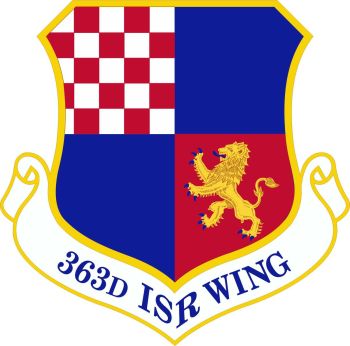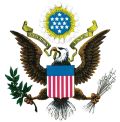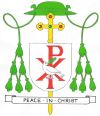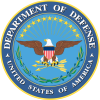363rd Intelligence, Surveillance and Reconnaissance Wing, US Air Force
363RD INTELLIGENCE, SURVEILLANCE AND RECONNAISSANCE WING, US AIR FORCE
History: Established as 363 Reconnaissance Wing on 29 July 1947. Organized on 15 August 1947. Redesignated as 363 Tactical Reconnaissance Wing on 14 June 1948. Inactivated on 26 April 1949. Activated on 1 September 1950. Redesignated as: 363 Tactical Fighter Wing on 1 October 1981; 363 Fighter Wing on 1 October 1991. Inactivated on 31 December 1993. Redesignated as 363 Air Expeditionary Wing and converted to provisional status on 19 November 1998. Activated on 1 December 1998. Inactivated on 25 August 2003. Withdrawn as provisional unit on 24 May 2007. Redesignated as 363 Flying Training Group on 25 May 2007. Activated on 1 June 2007. Inactivated on 1 August 2011. Redesignated as 363 Intelligence, Surveillance, and Reconnaissance Wing on 13 February 2015. Activated on 17 February 2015. Day and night photographic and visual reconnaissance, 1947-1949. In addition to tactical electronic and photographic reconnaissance, September 1950-April 1951, controlled light bombardment and provided replacement training for B-26 crew members. Wing headquarters not operational, 25 April-10 October 1951. During this period all members of the headquarters were integrated into the Tactical Air Division Provisional, and wing components were attached to the division for control. Regained wing integrity on 11 October 1951. In addition to tactical reconnaissance, October 1951-1989, provided electronic and weather reconnaissance from November 1953-March 1974, dropping the weather mission in December 1964. Provided combat crew training for reconnaissance aircrews, October 1951-December 1954 and April 1956-April 1959. Deployed aircraft and aircrews in small detachments, or as part of composite squadrons, to support reconnaissance requirements in overseas areas. Played an important reconnaissance role during the Cuban Missile Crisis of 1962, earning an Air Force Outstanding Unit Award (AFOUA) as a result, the decoration being personally presented by President John F. Kennedy. Played a major reconnaissance role during the Dominican Republic Crisis of 1965-1966. Supported operations in Southeast Asia in the 1960s and early 1970s by deploying numerous detachments and transferring several highly trained squadrons to that area. Also provided replacement training of tactical reconnaissance and electronics warfare crews, and combat crew training, January 1966-1974. Flew numerous test projects for the Tactical Air Reconnaissance Center, 1966-1967 and again in 1970-1971. Deployed a detachment of EB-66s to the Far East during the Pueblo crisis of 1968. In Mar 1974, the wing ceased training and employing electronic warfare forces, but it continued to train for and perform tactical reconnaissance missions, including aerial photography for various federal agencies. While continuing to operate Shaw AFB, in 1982 the wing began to train for and perform fighter missions in addition to tactical reconnaissance, becoming the Tactical Air Command’s only wing with such a dual role. In 1989, the wing gave up its reconnaissance responsibilities but continued to train for fighter missions. Between August 1990 and March 1991, the wing deployed most of its aircraft and personnel to southwestern Asia, where they participated in Operations Desert Shield and Desert Storm. In December 1992, a member of one of the wing’s squadrons (33 FS) earned the first USAF aerial victory credit ever scored by an F-16 pilot. The wing inactivated at the end of 1993. Conducted combat operations in support of Operations Southern Watch and Enduring Freedom, 1998-2003. Between 2007 and 2011, the 363 Flying Training Group built partnership and tactical capabilities, and improved interoperability to facilitate integrated air operations and missile defense among regional partners in the Persian Gulf area. Since 2015, the 363 Intelligence, Surveillance, and Reconnaissance Wing served as the USAF’s premier source for special operations intelligence, surveillance, and reconnaissance (ISR); full spectrum targeting and analysis, and ISR testing, tactics development, and advanced training.
| English | blazon wanted |
Origin/meaning
The Emblem was approved on 16 June 1952, scroll modified on 19 May 2010.
Literature: Image and Information from https://www.afhra.af.mil/
US heraldry portal
This page is part of the US heraldry portal |
Heraldry of the World |
|
US heraldry:
|
Ecclesiastical Heraldry of the USA:
Military Heraldry: |
Contact and Support
Partners:
Your logo here ?
Contact us
© since 1995, Heraldry of the World, Ralf Hartemink 
Index of the site















